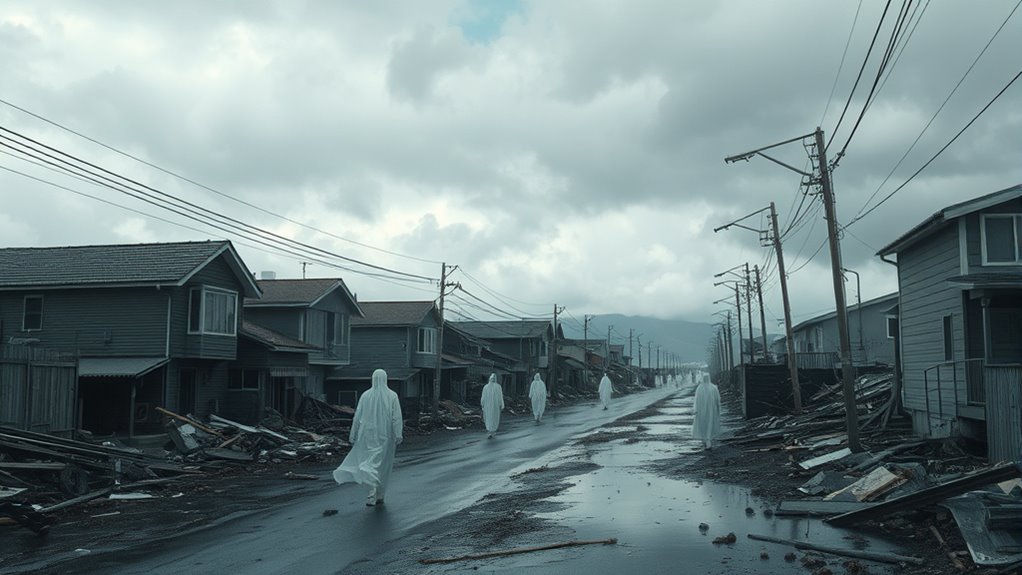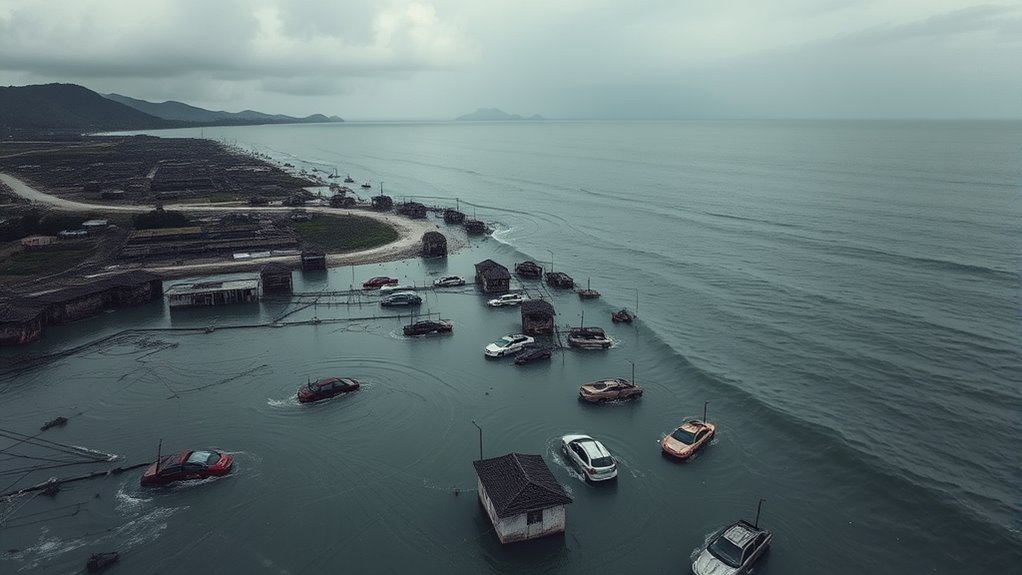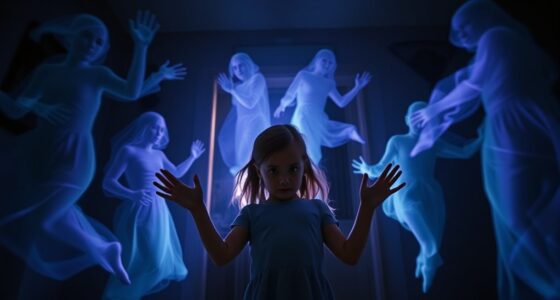After Japan’s 2011 tsunami, many survivors reported eerie encounters like fleeting shadows, whispers, and spirits near flooded areas, believed to be the drowned seeking closure. These supernatural stories often serve as emotional outlets, helping people process grief and trauma rooted in deep cultural traditions of spirits and ancestors. Such experiences reinforce collective memory and resilience, blending folklore with ongoing emotional healing. If you continue exploring, you’ll uncover more about how these encounters shape cultural responses to tragedy.
Key Takeaways
- Encounters with spirits and shadowy figures reflect survivors’ grief and trauma after the 2011 tsunami.
- Cultural beliefs in spirits and ancestral reverence shape interpretations of supernatural sightings.
- Stories of ghosts serve to preserve collective memory and offer emotional closure for communities.
- Supernatural experiences act as coping mechanisms, helping individuals process loss and guilt.
- These phenomena illustrate the deep psychological and cultural impact of the disaster on Japanese society.

When the devastating 2011 tsunami struck Japan, it left more than just physical destruction behind; it also gave rise to haunting stories of ghostly apparitions and unexplained phenomena. Many survivors and witnesses report experiencing supernatural encounters that seem to transcend ordinary understanding. These encounters often involve fleeting figures seen at the edges of vision, shadowy shapes appearing near flooded areas, or whispers carried by the wind long after the waters receded. For some, these visions are dismissed as grief or hallucinations, but for others, they serve as haunting reminders of the tragedy’s emotional toll. The tsunami’s immense destruction not only claimed lives but also deeply affected the mental health of those affected. Psychological trauma runs deep, and for many, these supernatural encounters become manifestations of unprocessed grief and guilt. Witnesses describe feeling an overwhelming sense of presence, as if the spirits of the drowned linger, seeking closure or connection. Such experiences often amplify feelings of vulnerability, fear, and despair, blurring the line between reality and the supernatural. It’s no surprise that these hauntings have entered local folklore, with stories passed down of ghostly figures offering silent companionship or warning messages to the living. These stories serve a dual purpose: helping survivors process their trauma and preserving memories of those lost. Psychologists have noted that traumatic events like the tsunami can trigger phenomena where the mind seeks comfort or understanding through supernatural experiences. These encounters may provide a sense of ongoing connection to loved ones who perished or act as a subconscious way for survivors to cope with their grief. The cultural context of Japan, with its rich traditions of spirits and ancestral reverence, also influences how these stories are perceived and shared. Many survivors interpret these supernatural encounters as spiritual visits, believing that the spirits of the deceased have not yet found peace. Understanding psychological trauma can shed light on how grief manifests in supernatural phenomena. Additionally, cultural beliefs play a significant role in shaping how these experiences are understood and accepted within the community. The role of folklore is significant in how these stories are passed down and interpreted, often providing comfort or explanations for the supernatural. Interestingly, the power of storytelling further reinforces collective memory and cultural resilience in the aftermath of disaster. Recognizing the psychological impact of trauma helps in understanding why such supernatural stories persist and are embraced by many communities. Whether viewed as genuine ghostly apparitions or manifestations of psychological trauma, these stories highlight the profound impact the tsunami had on the collective psyche. They remind us that beyond physical damages, natural disasters leave lasting emotional scars that can manifest in ways beyond the tangible. As Japan continues to rebuild, the stories of ghostly figures and unexplained phenomena remain a poignant testament to the enduring trauma and the human need for connection, closure, and understanding in the face of unimaginable loss.
Frequently Asked Questions
How Do Local Communities Cope With Grief Long-Term?
You can see that local communities cope with grief long-term through community rituals and grief counseling. Participating in memorial ceremonies helps them honor loved ones and maintain collective memory. Grief counseling offers emotional support, allowing individuals to process their loss. These practices foster resilience and unity, helping communities heal together over time. By staying connected through rituals and counseling, they turn grief into a source of strength and continuity.
Are There Government Programs Supporting Ghost Sightings?
You might be surprised to learn that over 60% of people in affected areas report ghost sightings. The government initiates programs aimed at mental health support, helping residents cope with grief and trauma. These initiatives include counseling, community gatherings, and awareness campaigns. While they don’t directly address ghost sightings, they foster healing and reduce fears, showing the government’s commitment to supporting long-term emotional well-being in communities affected by tragedy.
Have Similar Phenomena Been Reported After Other Natural Disasters?
You might notice that after other natural disasters, people often report supernatural folklore, like ghost sightings, as a way to process disaster trauma. These phenomena seem to emerge worldwide, helping survivors cope with loss and chaos. While not scientifically confirmed, such reports reflect deep psychological and cultural responses to tragedy. So, yes, similar ghost sightings and supernatural stories have been documented following various disasters, illustrating how folklore helps communities confront trauma.
What Psychological Effects Do These Ghost Stories Have on Residents?
Imagine ghost stories as echoes of psychological trauma that resonate through a community, shaping how residents cope. These stories can deepen fears but also strengthen community resilience, serving as shared narratives that unite people in facing grief. While they may evoke anxiety, they also remind residents of their collective strength, helping them rebuild mental resilience after disasters. Such stories become both a shadow of trauma and a beacon of hope.
How Do Cultural Beliefs Influence Perceptions of These Spirits?
You see that cultural beliefs deeply shape how you perceive spirits, as supernatural symbolism reflects society’s values and fears. These beliefs turn spirits into symbols of unresolved trauma or memories, anchoring them in cultural memory. Your understanding of these spirits is influenced by traditions, stories, and collective history, which frame them as protective, vengeful, or mournful, shaping your emotional response and perceptions of their presence or significance.
Conclusion
As you reflect on Japan’s tsunami ghosts, remember they’re like whispers carried by the wind—haunting yet guiding. Their presence reminds you that even in tragedy, echoes of the past shape the future. Just as a river’s flow can’t be stopped, these spirits flow through history, urging us to honor and learn. Embrace their silent lessons, for they’re the ghosts that linger, shaping tomorrow’s hope from yesterday’s sorrow.









